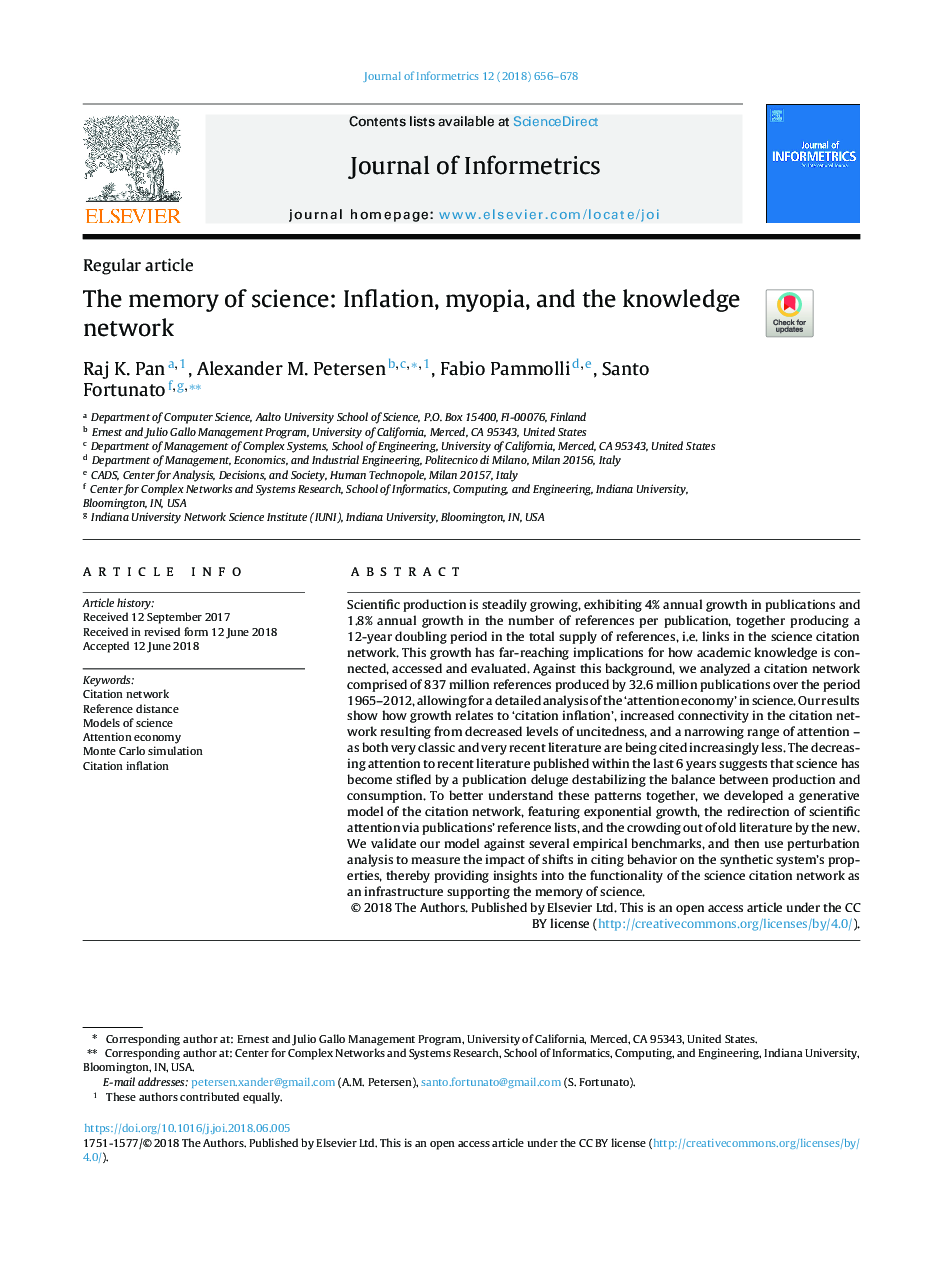| کد مقاله | کد نشریه | سال انتشار | مقاله انگلیسی | نسخه تمام متن |
|---|---|---|---|---|
| 6933976 | 1449489 | 2018 | 23 صفحه PDF | دانلود رایگان |
عنوان انگلیسی مقاله ISI
The memory of science: Inflation, myopia, and the knowledge network
ترجمه فارسی عنوان
حافظه علم: تورم، نزدیک بینی، و شبکه دانش
دانلود مقاله + سفارش ترجمه
دانلود مقاله ISI انگلیسی
رایگان برای ایرانیان
کلمات کلیدی
شبکه استناد فاصله مرجع، مدلهای علم، توجه اقتصادی، شبیه سازی مونت کارلو، تورم استنادی
ترجمه چکیده
تولید علمی به طور پیوسته رشد می کند و رشد سالیانه 4٪ در نشریات و رشد سالیانه 1.8٪ در تعداد مراجع در هر نشر را نشان می دهد و همزمان دوبرابر شدن دوره 12 ساله در کل منبع ارجاعات، یعنی لینک ها در شبکه استناد علمی است. این رشد پیامد های گسترده ای برای دانش آکادمیک دارد که در آن متصل، دسترسی و ارزیابی شده است. در مقابل این زمینه، یک شبکه استنادی را که شامل 837 میلیون نسخه بوده و طی سالهای 1965-2012 منتشر شده است، 32.6 میلیون نسخه منتشر کردیم، که امکان تجزیه و تحلیل دقیق اقتصاد توجه را در علم فراهم کرد. نتایج ما نشان می دهد که چگونه رشد به "تورم استناد" مربوط می شود، افزایش ارتباط در شبکه استناد منجر به کاهش سطوح عدم پذیرش و محدود بودن میزان توجه - همانطور که ادبیات بسیار کلاسیک و اخیرا به طور فزاینده ای کمتر اشاره شده است. توجه کمتری به ادبیات اخیر که طی شش سال گذشته منتشر شده است، نشان می دهد که علم با انتشار یک نشریه، بی ثباتی توازن بین تولید و مصرف را مختل کرده است. برای بهتر درک این الگوهای با هم، ما یک مدل نسبی از شبکه استنادی ایجاد کردیم که نشان دهنده رشد چشمگیر، هدایت توجه علمی از طریق فهرست مرجع نشریات و بیرون آمدن از ادبیات قدیمی توسط جدید است. ما مدل ما را در برابر چندین معیار تجربی تأیید می کنیم و سپس از تحلیل تحریف برای اندازه گیری تاثیر شیفت ها در رفتار ذکر شده در خواص سیستم مصنوعی استفاده می کنیم، در نتیجه، بینش به عملکرد شبکه نشریه علمی به عنوان یک زیرساخت حمایت از حافظه علم.
موضوعات مرتبط
مهندسی و علوم پایه
مهندسی کامپیوتر
نرم افزارهای علوم کامپیوتر
چکیده انگلیسی
Scientific production is steadily growing, exhibiting 4% annual growth in publications and 1.8% annual growth in the number of references per publication, together producing a 12-year doubling period in the total supply of references, i.e. links in the science citation network. This growth has far-reaching implications for how academic knowledge is connected, accessed and evaluated. Against this background, we analyzed a citation network comprised of 837 million references produced by 32.6 million publications over the period 1965-2012, allowing for a detailed analysis of the 'attention economy' in science. Our results show how growth relates to 'citation inflation', increased connectivity in the citation network resulting from decreased levels of uncitedness, and a narrowing range of attention - as both very classic and very recent literature are being cited increasingly less. The decreasing attention to recent literature published within the last 6 years suggests that science has become stifled by a publication deluge destabilizing the balance between production and consumption. To better understand these patterns together, we developed a generative model of the citation network, featuring exponential growth, the redirection of scientific attention via publications' reference lists, and the crowding out of old literature by the new. We validate our model against several empirical benchmarks, and then use perturbation analysis to measure the impact of shifts in citing behavior on the synthetic system's properties, thereby providing insights into the functionality of the science citation network as an infrastructure supporting the memory of science.
ناشر
Database: Elsevier - ScienceDirect (ساینس دایرکت)
Journal: Journal of Informetrics - Volume 12, Issue 3, August 2018, Pages 656-678
Journal: Journal of Informetrics - Volume 12, Issue 3, August 2018, Pages 656-678
نویسندگان
Raj K. Pan, Alexander M. Petersen, Fabio Pammolli, Santo Fortunato,
